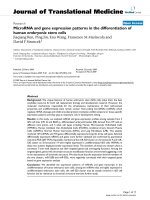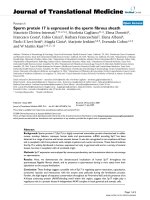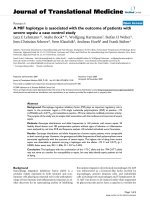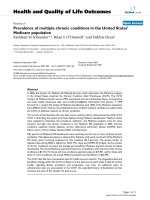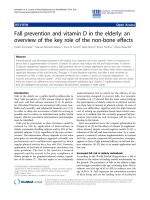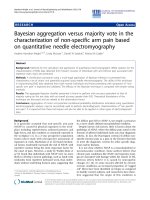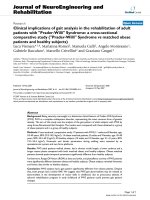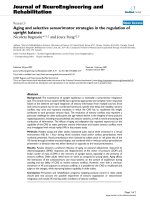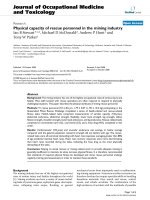báo cáo hóa học:" Sperm protein 17 is expressed in the sperm fibrous sheath" ppt
Bạn đang xem bản rút gọn của tài liệu. Xem và tải ngay bản đầy đủ của tài liệu tại đây (357.94 KB, 5 trang )
BioMed Central
Page 1 of 5
(page number not for citation purposes)
Journal of Translational Medicine
Open Access
Research
Sperm protein 17 is expressed in the sperm fibrous sheath
Maurizio Chiriva-Internati*
†1,2,3,4
, Nicoletta Gagliano
†1,4
, Elena Donetti
4
,
Francesco Costa
4
, Fabio Grizzi
5
, Barbara Franceschini
5
, Elena Albani
6
,
Paolo E Levi-Setti
6
, Magda Gioia
4
, Marjorie Jenkins
7,8,9
, Everardo Cobos
1,2,3
and W Martin Kast
3,10,11,12
Address:
1
Division of Hematology & Oncology, Texas Tech University Health Sciences Center Lubbock, TX, USA,
2
Southwest Cancer Treatment
and Research Center, Texas Tech University Health Sciences Center Lubbock, TX, USA,
3
Kiromic, Inc Lubbock, TX, USA,
4
Department of Human
Morphology, University of Milan, Milan, Italy,
5
Laboratories of Quantitative Medicine, Istituto Clinico Humanitas IRCCS, Rozzano, Milan, Italy,
6
Department of Reproductive Pathology, Istituto Clinico Humanitas, Rozzano, Milan, Italy,
7
Department of Internal Medicine, Texas Tech
University Health Sciences Center, Amarillo, TX, USA,
8
Department of Obstetrics & Gynecology, Texas Tech University Health Sciences Center,
Amarillo, TX, USA,
9
Laura W Bush Institute for Women's Health and Center for Women's Health and Gender-Based Medicine, Texas Tech
University Health Sciences Center, Amarillo, TX, USA,
10
Department of Molecular Microbiology & Immunology, Norris Comprehensive Cancer
Center, University of Southern California, Los Angeles, CA, USA,
11
Department of Obstetrics & Gynecology, Norris Comprehensive Cancer Center,
University of Southern California, Los Angeles, CA, USA and
12
Cancer Research Center of Hawaii, University of Hawaii at Manao, Honolulu,
Hawaii, USA
Email: Maurizio Chiriva-Internati* - ; Nicoletta Gagliano - ;
Elena Donetti - ; Francesco Costa - ; Fabio Grizzi - ;
Barbara Franceschini - ; Elena Albani - ; Paolo E Levi-
Setti - ; Magda Gioia - ; Marjorie Jenkins - ;
Everardo Cobos - ; W Martin Kast -
* Corresponding author †Equal contributors
Abstract
Background: Sperm protein 17 (Sp17) is a highly conserved mammalian protein characterized in rabbit,
mouse, monkey, baboon, macaque, human testis and spermatozoa. mRNA encoding Sp17 has been
detected in a range of murine and human somatic tissues. It was also recognized in two myeloma cell lines
and in neoplastic cells from patients with multiple myeloma and ovarian carcinoma. These data all indicate
that Sp17 is widely distributed in humans, expressed not only in germinal cells and in a variety of somatic
tissues, but also in neoplastic cells of unrelated origin.
Methods: Sp17 expression was analyzed by immunocytochemistry and transmission electron microscopy
on spermatozoa.
Results: Here, we demonstrate the ultrastructural localization of human Sp17 throughout the
spermatozoa flagellar fibrous sheath, and its presence in spermatozoa during in vitro states from their
ejaculation to the oocyte fertilization.
Conclusion: These findings suggest a possible role of Sp17 in regulating sperm maturation, capacitation,
acrosomal reaction and interactions with the oocyte zona pellucida during the fertilization process.
Further, the high degree of sequence conservation throughout its N-terminal half, and the presence of an
A-kinase anchoring protein (AKAP)-binding motif within this region, suggest that Sp17 might play a
regulatory role in a protein kinase A-independent AKAP complex in both germinal and somatic cells.
Published: 15 July 2009
Journal of Translational Medicine 2009, 7:61 doi:10.1186/1479-5876-7-61
Received: 29 December 2008
Accepted: 15 July 2009
This article is available from: />© 2009 Chiriva-Internati et al; licensee BioMed Central Ltd.
This is an Open Access article distributed under the terms of the Creative Commons Attribution License ( />),
which permits unrestricted use, distribution, and reproduction in any medium, provided the original work is properly cited.
Journal of Translational Medicine 2009, 7:61 />Page 2 of 5
(page number not for citation purposes)
Background
The interaction of capacitated spermatozoa with the zona
pellucida (ZP) of the oocyte is a complex process involv-
ing a high number of spermatic molecules [1]. A family of
low molecular weight sperm autoantigens has been recog-
nized in rabbit spermatogenic cells and mature spermato-
zoa, and shown to bind the carbohydrate components of
the ZP[2]. Among them, a mannose-binding protein
called Sperm protein 17 (Sp17) was firstly isolated,
sequenced and characterised in rabbit [3] and subse-
quently in a wide range of mammalian species [4-7]. As in
rabbit and mouse [4], human Sp17 has been identified to
be an autoantigen in sera from both vasectomized and
vasostomized men [7]. Although Sp17 was originally
thought to be gamete-specific, mRNA encoding Sp17 has
been found in a range of murine [8] and human somatic
tissues [9]. It was also detected in two myeloma cell lines
[10] and in neoplastic cells from patients with multiple
myeloma and ovarian carcinoma [11,12]. Using self-pro-
duced mouse anti-human Sp17 antibodies, this protein
was recognized in the cytoplasm of some spermatocytes
and that of early and late spermatids [13]. The flagella of
the spermatozoa in the lumen of the seminiferous tubules
was also found to be immunopositive for Sp17. Recently,
Sp17 was found expressed in the synoviocytes of females
affected by rheumatoid arthritis [14], human ciliated epi-
thelia [15] and the melanophages of cutaneous melano-
cytic lesions [16].
All these data demonstrate that Sp17 is more widely dis-
tributed in humans than originally thought, expressed not
only in germinal cells and in a variety of somatic tissues,
but also in neoplastic cells of unrelated histological ori-
gin. For this reason, the definition of the biological role of
Sp17 remains an open question.
The present study was aimed at investigating the localiza-
tion of Sp17 by morphological methods during in vitro
states of the dynamical process that spermatozoa go
through from sperm ejaculation to the oocytes fertiliza-
tion, since currently we do not know whether human
Sp17 is localized on the surface of the spermatozoa, after
sperm-ZP contact occurs. In addition, we aimed at analyz-
ing the ultra-structural localization of Sp17 in human
spermatozoa by electron microscopy in order to provide
new information useful in understanding the biological
function of Sp17.
Methods
Samples
The study, using human subjects, was carried out in
accordance with the guidelines of the Ethics Committee of
the hospitals involved.
Spermatozoa collected by ejaculation within a minimum of
48 hours but not longer than seven days of sexual abstinence
from 26 fertile donors were analyzed. Motile and morpho-
logically normal spermatozoa were selected using a discon-
tinuous PureSperm gradient (Nidacon Laboratoires, AB,
Gothenburg, Sweden), and some were incubated at 37°C for
45 minutes in a hypo-osmotic medium in order to assess the
functional integrity of the sperm plasma membrane.
To evaluate the expression of Sp17 in ZP-bounded sper-
matozoa, ZPs were collected from empting immature
non-inseminated oocytes or non-fertilized oocytes after
intracytoplasmic sperm injection (ICSI). Each ZP was
incubated overnight with treated semen and then
removed and pipetted in order to dislodge loosely
attached spermatozoa. Sperm collection, viability, hypo-
osmotic swelling test and ZP binding were performed in
accordance with the instructions in the WHO laboratory
manual for the examination of human semen and sperm-
cervical mucus interaction [17].
Immunocytochemical analysis
To investigate the immunocytochemical expression of
Sp17, spermatozoa were fixed with Biofix (Bio-Optica,
Milan, Italy), and subsequently permeabilized with 0.5%
Triton X-100 (Sigma Ltd, Missouri, USA); 0.1% sodium
citrate in phosphate buffered saline, PBS) at 4°C for 15
minutes, followed by treatment with either primary
mouse antibodies raised against human Sp17 [13-15] at
room temperature for two hours, or with 1 μg/ml mouse
IgG1 (Dako, Milan, Italy) as a negative control. This was
followed by 30 minutes incubation with the DAKO Envi-
sion System (Dako, Milan, Italy). 3, 3'-diaminobenzidine
tetrahydrochloride (Sigma Ltd, Missouri, USA, 12.5 mg
and 500 μl H
2
O
2
in 50 ml of TRIS buffer saline) was used
as a chromogen to yield brown reaction products. Almost
one thousand spermatozoa were counted under a light
microscopy (Leica DMLA, Milan, Italy) and the number of
those immunopositive for Sp17 was expressed as the
mean percent ± SD of all spermatozoa.
Transmission electron microscopy
Sperm pellets were centrifuged twice at 1100 rpm for 10
minutes and samples were fixed 4 hours either in 3% glu-
taraldehyde in PBS to perform ultrastructural analysis or
in 4% formaldehyde in PBS pH 7.4 at 4°C to evaluate
Sp17 ultra-structural localization. All cell pellets were
then washed with PBS. For ultrastructural analysis, cells
were post-fixed in 1% osmium tetroxide (OsO
4
) in 0.1 M
PBS, dehydrated through an ascending series of aceton,
and embedded in Durcupan (Fluka). Ultrathin sections
were obtained with an Ultracut ultramicrotome (Reichert-
Jung), stained with uranyl acetate and lead citrate before
examination by a Jeol CX100 electron microscope (Jeol,
Tokyo, Japan).
Formaldehyde-fixed cells were immersed in NH
4
Cl 0.25
M in PBS overnight at 4°C and embedded in Durcupan
Journal of Translational Medicine 2009, 7:61 />Page 3 of 5
(page number not for citation purposes)
(Fluka) K4M After washing, samples were dehydrated in
ascending concentrations of cold ethanol, embedded in
Lowicryl K4M (Agar, Polysciences Inc., Stansted, UK) at -
35°C and polymerized under UV light (360 nm) at -35°C
for a week. Ultrathin sections were cut by a diamond knife
with a Reichert Ultracut R ultramicrotome and collected
on celloidine-coated 100 mesh nickel grids (Electron
Microscopy Sciences, Società Italiana Chimici, Rome,
Italy). For the immunogold procedure, sections were incu-
bated at room temperature with 0.03% saponin in 0.05 M
TBS/1% BSA (buffer A, pH 7.6) for 30 minutes and then
autoclaved at 121°C in EDTA 1 mM (pH 8) for 15 min-
utes. After cooling, grids were incubated for 2 hours with
mouse anti-human Sp17 antibodies [13-15]. After wash-
ing in buffer A, grids were incubated with a goat anti-
mouse IgG (Aurion, Wageningen, The Netherlands) for 1
hour at room temperature. Sections were then washed
and examined with a JEM 1010 transmission electron
microscope (Jeol, Tokyo, Japan) at 80 kV.
Results and discussion
Two distinct Sp17 populations, one immunopositive
(amounting for about 90% of all the spermatozoa) and
the other immunonegative, were recognized in all of the
three classes of investigated spermatozoa (density gradi-
ent, hypo-osmotic swelling, and ZP-bound spermatozoa).
At higher magnification, Sp17 is clearly detectable
throughout the principal piece of the flagellum, but the
intermediate piece, (Figure 1B) head and acrosomal vesi-
cle were always immunonegative (Figure 1A–C).
Although no differences were obtained comparing the
mean percentages of immunopositive spermatozoa
belonging to the three classes, an increased percentage of
immunopositive spermatozoa and a marked immunore-
activity were evident in ZP-bound spermatozoa (Figure
1C). Interestingly, changes in the integrity and compli-
ance of the sperm plasma membrane did not modify the
presence of Sp17 (Figure 1B).
Ultra-structural immunochemistry completely confirmed
light microscopy observations, clearly demonstrating that
spermatozoa expressed the Sp17 protein and that the
epitope recognized by Sp17 antibodies was localized
throughout the principal piece of the flagellum. Trans-
verse sections showed that immunoreactivity was
restricted to the fibrous sheath (FS) and no gold particles
were localized in the axoneme or in outer dense fibers
(Figure 2A). In longitudinal sections, Sp17 immuno-
labelling was more intense in the inner than in the outer
FS (Figure 2B).
The expression of Sp17 was previously demonstrated in
the differently differentiated stages of spermatozoa matu-
ration such as in spermatocytes, spermatids and sperma-
tozoa [13], and its marked developmentally regulated
increase in testis indicated that Sp17 plays an important
role in sperm function [9]. Moreover, the present findings
showed Sp17 immunoreaction with ZP of the oocyte.
These overall findings suggest a role of Sp17 during sperm
maturation, capacitation, acrosomal reaction and the fer-
tilization process.
In addition, the wide distribution in germinal, somatic
and tumoral cells indicates that the proposed role of Sp17
in ZP binding is unlikely to be its unique function as orig-
inally thought. In fact, immunohistochemical studies
showed that Sp17 is expressed not only in germinal tis-
sues, but also in the human respiratory airways and repro-
ductive systems, and in particular in ciliated cells [15].
The definition of Sp17 functional role is still an open
question. A re-evaluation of Sp17 has been recently intro-
duced by Frayne and Hall [9]. In an attempt to discover a
possible function of the extremely conserved N-terminal
Expression of Sp17 in human spermatozoa collected from fertile donorsFigure 1
Expression of Sp17 in human spermatozoa collected from fertile donors. Immunohistochemistry demonstrates that
Sp17 is localized throughout the principal piece of the flagellum. The expression of Sp17 is maintained in all of the three classes
of investigated spermatozoa: density-gradient (A), swelling (B), and ZP-bound spermatozoa (C) Although, we observed a
number of immunopositive spermatozoa was observed, ZP-bound spermatozoa show a more intense staining (C).
Journal of Translational Medicine 2009, 7:61 />Page 4 of 5
(page number not for citation purposes)
domain of Sp17, they noticed that this region contains a
motif (first 74 aminoacids) that is very similar to the N-
terminal sequence of the cAMP-dependent protein kinase
A regulatory subunit II (PKA RII), which is essential for
protein dimerisation and interaction with A-kinase
anchoring proteins (AKAPs). It is plausible that Sp17
plays a regulatory role in a PKA-independent AKAP com-
plex in both somatic and germinal cells. AKAPs represent
a family of sequence-unrelated proteins classified exclu-
sively by their ability to bind PKA in vitro, and possess tar-
geting domains that mediate their attachment to the
plasma membrane, cytoskeleton, or intracellular
organelles [18]. Furthermore, AKAPs bind simultaneously
to PKA and other signal transduction molecules, leading
to the hypothesis that their function is related to the coor-
dination of several signalling proteins [19-21].
Interestingly, it was demonstrated that Sp17 and AKAP3
are specifically associated in spermatozoa flagella [22];
since AKAP3 acts as a scaffold protein in binding various
components of signal transduction pathways, this evi-
dence may be relevant in understanding the functional
role of Sp17, and in particular, in relation to motility.
Actually, three sperm-specific AKAP-binding proteins
have been identified, namely ropporin [23], AKAP-associ-
ated sperm protein [24] and fibrousheathin II [25]. These
three proteins have been localized to the FS of the sperm
tail. Analogously, the present study is the first to demon-
strate by electron microscopy that Sp17 is a FS protein.
The FS is a unique cytoskeletal structure surrounding the
axoneme and outer dense fibers and defines the extent of
the principal region of the sperm flagellum. Despite a
number of proteins present in the FS having been identi-
fied [26], there is little experimental evidence shedding
light on the possible function of this sperm structure.
Interestingly, Kultgen et al [27] have recently provided the
first biochemical data showing that a pool of PKA was also
localized within human ciliary axonemes. Additionally,
they have identified the first human AKAP targeted to the
ciliary axoneme, named AKAP28 in cilia of columnar cells
of the respiratory airways, but not in goblet and basal
cells, and proposed that AKAP28 localizes PKA to a posi-
tion in the axoneme where it is able to readily interact
with its substrate. Similar results were obtained in ham-
ster oviducts by Morales et al [28]. These data reinforce the
idea that Sp17 might play an important role in cell signal-
ling in both somatic and germinal cells, as well as in cell
motility.
Sp17 was demonstrated to be highly expressed in tumor
tissues and cells [10-12,29]. A possible role of Sp17 was
demonstrated in transformed lymphoid and hematopoi-
etic cells [8], suggesting that Sp17 may be involved in
tumorigenesis mechanisms by its ability to mediate cell
adhesion and interaction, and therefore migration of
malignant cells [29].
Conclusion
In conclusion, the present study designates Sp17 as a
novel FS protein and shows the continuous presence of
this protein throughout the sperm tail from ejaculated
spermatozoa to the sperm-ZP binding phase. These data
contribute to the understanding of Sp17's biological role
and its possible clinical implications.
Abbreviations
AKAPs: kinase anchoring proteins; PKA: protein kinase A;
Sp17: sperm protein 17; ZP: zona pellucida.
Competing interests
The authors declare that they have no competing interests.
Authors' contributions
MCI carried out the study design, drafted the manuscript
and coordination and revised the manuscript and is
responsible of some of the sperm collection and viability
analysis.
NG participated in the design of the study, and revised the
manuscript.
FG participated in the design of the study, and revised the
manuscript.
Transmission electron microphotographs of human ejacu-lated spermatozoa collected from fertile donorsFigure 2
Transmission electron microphotographs of human
ejaculated spermatozoa collected from fertile
donors. A: Araldite transverse section; B and C: Sp17 immu-
nogold labeling in Lowycril transverse (B) and longitudinal
(C) sections. Immunoreactivity was restricted to the fibrous
sheath and no gold particles were localized in the axonema
or in outer dense fibers. Original magnification: A: 29000; B
and C: 25000×.
Publish with BioMed Central and every
scientist can read your work free of charge
"BioMed Central will be the most significant development for
disseminating the results of biomedical research in our lifetime."
Sir Paul Nurse, Cancer Research UK
Your research papers will be:
available free of charge to the entire biomedical community
peer reviewed and published immediately upon acceptance
cited in PubMed and archived on PubMed Central
yours — you keep the copyright
Submit your manuscript here:
/>BioMedcentral
Journal of Translational Medicine 2009, 7:61 />Page 5 of 5
(page number not for citation purposes)
ED performed electron microscope analysis.
FC performed immunohistochemical analysis.
BF performed immunohistochemical analysis.
EA is responsible of sperm collection, viability analysis,
hypo-osmotic swelling test and zona pellucida binding.
PLS revised the manuscript.
MG revised the manuscript.
MJ participated in study design and coordination, and
revised the manuscript.
EC participated in study design and coordination and
revised the manuscript.
WMK participated in study design and coordination and
revised and drafted the manuscript.
All authors read and approved the final manuscript.
Acknowledgements
We thank Teri Fields for her assistance in editing this manuscript. W. Mar-
tin Kast holds the Walter A. Richter Cancer Research Chair.
References
1. Primakoff P, Myles DG: Penetration, adhesion, and fusion in
mammalian sperm-egg interaction. Science 2002,
296:2183-2185.
2. O'Rand MG, Porter JP: Purification of rabbit sperm autoantigens
by preparative SDS gel electrophoresis: amino acid and carbo-
hydrate content of RSA-1. Biol Reprod. 1982, 27(3):713-721.
3. Richardson RT, Yamasaki N, O'Rand MG: Sequence of a rabbit
sperm zona pellucida binding protein and localization during
the acrosome reaction. Dev Biol 1994, 165:688-701.
4. Kong M, Richardson RT, Widgren EE, O'Rand MG: Sequence and
localization of the mouse sperm autoantigenic protein,
Sp17. Biol Reprod 1995, 53:579-590.
5. Lea IA, Richardson RT, Widgren EE, O'Rand MG: Cloning and
sequencing of cDNAs encoding the human sperm protein,
Sp17. Biochim Biophys Acta 1996, 1307:263-266.
6. Adoyo PA, Lea IA, Richardson RT, O'Rand MG: Sequence and
characterization of the sperm protein sp17 from the baboon.
Mol Reprod Dev. 1997, 47(1):66-71.
7. Lea IA, Adoyo P, O'Rand MG: Autoimmunogenicity of the
human sperm protein Sp17 in vasectomized men and identi-
fication of linear B cell epitopes. Fertil Steril 1997, 67:355-361.
8. Wen Y, Richardson RT, Widgren EE, O'Rand MG: Characteriza-
tion of Sp17: a ubiquitous three domain protein that binds
heparin. Biochem J 2001, 357:25-31.
9. Frayne J, Hall L: A re-evaluation of sperm protein 17 (Sp17)
indicates a regulatory role in an A-kinase anchoring protein
complex, rather than a unique role in sperm-zona pellucida
binding. Reproduction 2002, 124:767-774.
10. Lim SH, Wang Z, Chiriva-Internati M, Xue Y: Sperm protein 17 is
a novel cancer-testis antigen in multiple myeloma. Blood
2001, 97:1508-1510.
11. Chiriva-Internati M, Wang Z, Salati E, Bumm K, Barlogie B, Lim SH:
protein 17 (Sp17) is a suitable target for immunotherapy of
multiple myeloma. Blood 2002, 100:961-965.
12. Chiriva-Internati M, Wang Z, Salati E, Timmins P, Lim SH: Tumor
vaccine for ovarian carcinoma targeting sperm protein 17.
Cancer 2002, 94:2447-2453.
13. Grizzi F, Chiriva-Internati M, Franceschini B, Hermonat PL, Soda G,
Lim SH, Dioguardi N: Immunolocalisation of sperm protein 17
in human testis and ejaculated spermatozoa. J Histochem Cyto-
chem. 2003, 51(9):1245-1248.
14. Takeoka Y, Kenny TP, Yago H, Naiki M, Gershwin ME, Robbins DL:
Developmental considerations of sperm protein 17 gene
expression in rheumatoid arthritis synoviocytes. Dev Immunol
2002, 9:97-102.
15. Grizzi F, Chiriva-Internati M, Franceschini B, Bumm K, Colombo P, Cic-
carelli M, Donetti E, Gagliano N, Hermonat PL, Bright RK, Gioia M, Dio-
guardi N, Kast WM: Sperm protein 17 is expressed in human
somatic ciliated epithelia. J Histochem Cytochem 2004, 52:549-554.
16. Franceschini B, Grizzi F, Colombo P, Soda G, Bumm K, Hermonat PL,
Monti M, Dioguardi N, Chiriva-Internati M: Expression of human
sperm protein 17 in melanophages of cutaneous melanocytic
lesions. Br J Dermatol 2004, 150:780-782.
17. WHO Laboratory Manual for the Examination of Human
Semen and Sperm-Cervical Mucus Interaction. Cambridge
University Press; 1999.
18. Colledge M, Scott JD: AKAPs: from structure to function.
Trends Cell Biol 1999, 9:216-221.
19. Coghlan VM, Perrino BA, Howard M, Langeberg LK, Hicks JB, Gallatin
WM, Scott JD: Association of protein kinase A and protein
phosphatase 2B with a common anchoring protein. Science
1995, 267:108-112.
20. Klauck TM, Faux MC, Labudda K, Langeberg LK, Jaken S, Scott JD:
Coordination of three signalling enzymes by AKAP79, a
mammalian scaffold protein. Science 1996, 271:1589-1592.
21. Shih M, Lin F, Scott JD, Wang HY, Malbon CC: Dynamic complexes
of beta2-adrenergic receptors with protein kinases and phos-
phatases and the role of gravin. J Biol Chem 1999, 274:1588-1595.
22. Lea IA, Widgren EE, O'Rand MG: Association of sperm protein
17 with A-kinase anchoring protein 3 in flagella.
Reprod Biol
Endocrinol 2004, 2:57.
23. Carr DW, Fujita A, Stentz CL, Liberty GA, Olson GE, Narumiya S:
Identification of sperm-specific proteins that interact with
A-kinase anchoring proteins in a manner similar to the type
II regulatory subunit of PKA. J Biol Chem 2001, 276:17332-17338.
24. Anway MD, Ravindranath N, Dym M, Griswold MD: Identification
of a murine testis complementary DNA encoding a homolog
to human A-kinase anchoring protein-associated sperm pro-
tein. Biol Reprod 2002, 66:1755-17561.
25. Naaby-Hansen S, Mandal A, Wolkowicz MJ, Sen B, Westbrook VA,
Shetty J, Coonrod SA, Klotz KL, Kim YH, Bush LA, Flickinger CJ, Herr
JC: CABYR, a novel calcium-binding tyrosine phosphoryla-
tion-regulated fibrous sheath protein involved in capacita-
tion. Dev Biol 2002, 242:236-254.
26. Eddy EM, Toshimori K, O'Brien DA: Fibrous sheath of mamma-
lian spermatozoa. Microsc Res Tech 2003, 61:103-115.
27. Kultgen PL, Byrd SK, Ostrowski LE, Milgram SL: Characterization
of an A-kinase anchoring protein in human ciliary axonemes.
Mol Biol Cell 2002, 13:4156-4166.
28. Morales B, Barrera N, Uribe P, Mora C, Villalón M: Functional cross
talk after activation of P2 and P1 receptors in oviductal cili-
ated cells. Am J Physiol Cell Physiol 2000, 279:C658-C669.
29. Lacy HM, Sanderson RD: Sperm protein 17 is expressed on nor-
mal and malignant lymphocytes and promotes heparan sul-
fate-mediated cell-cell adhesion. Blood 2001, 98:2160-2165.

